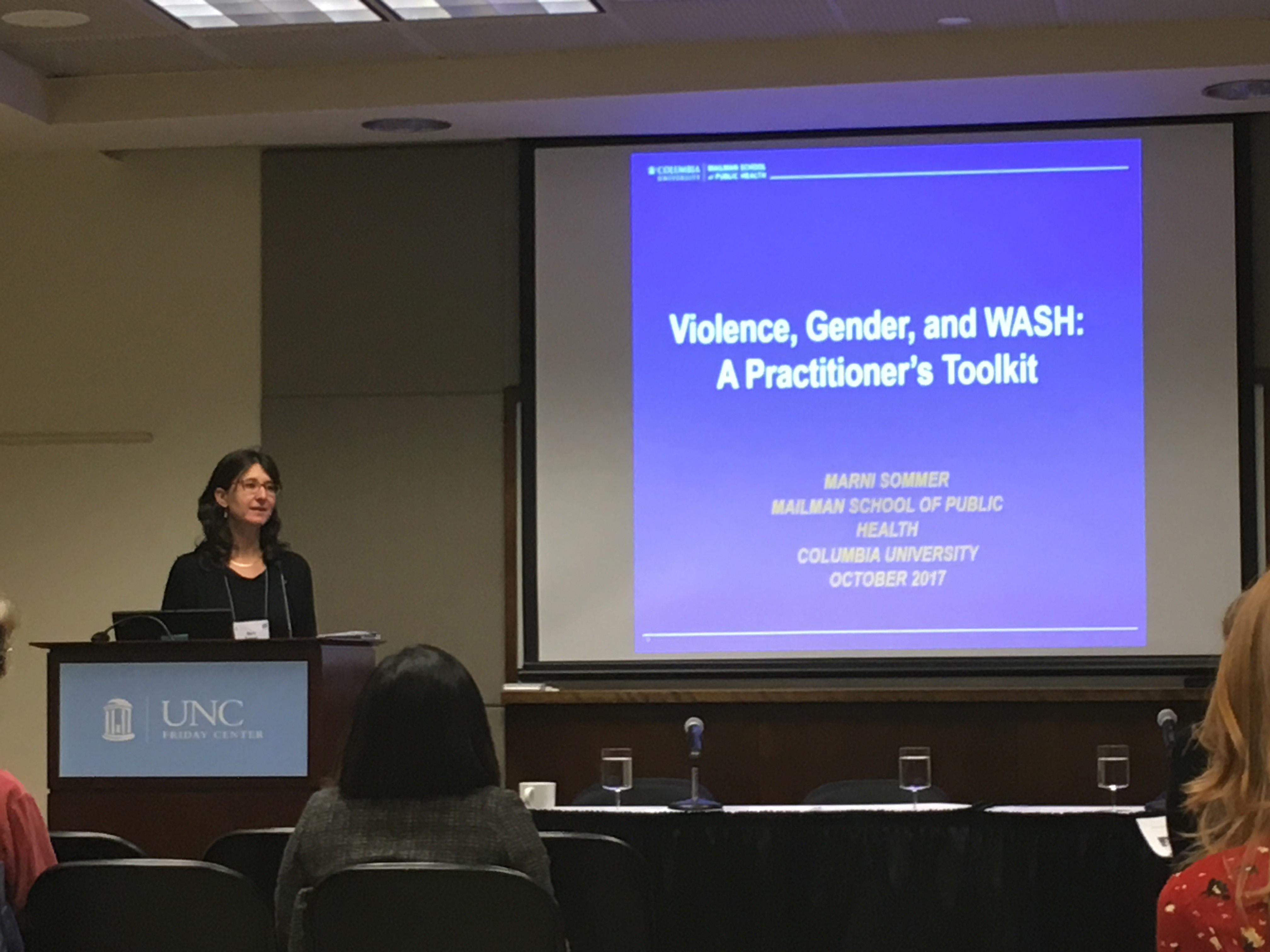Where Science meets Policy: Reflections from UNC

Marni Sommer presenting at UNC.
In October, Joanna Esteves Mills, SHARE's Policy Research Manager attended the University of North Carolina annual Water & Health Conference. Here, she provides some insights into the conference and some of the key sessions.
This year at the UNC Water & Health Conference the topics were as diverse and the sessions as interesting as ever. The theme year was ‘Where Science Meets Policy’, and I think that felt apt – most conference veterans I’ve spoken to say that it has gone from being a firmly academic conference, to one with a rich mix of researchers, policy-makers, practitioners and funders. The conference increasingly acts as a bridge between policy and practice.
I find this particularly attractive because of my own interest in the relationship between evidence and practice. How is demand for knowledge by policymakers and practitioners identified? How does new knowledge make its way to informing what we do and how we do it? And what do we even mean by ‘knowledge’? What type of evidence is enough to promote action? One thing seems clear to me – it must be about good relationship-building and communication.
But, of course, the evidence-practice relationship can also sometimes be fraught, and one plenary session tackled this head-on, identifying itself as ‘couples counselling’ for the researcher and practitioner... A joke which got lots of laughs, but also quite a few knowing nods!
Interpreting evidence
Lots of what I saw and heard at UNC gave food for thought on this topic. On the issue of how knowledge makes its way to practice, the session on the WASH Benefits cluster-RCTs was particularly interesting. The session was excellent, presenting a huge amount of complex data clearly and succinctly and allowing for lots of discussion. It revealed that the much anticipated – and as yet unpublished – findings do not produce homogenous, conclusive evidence on the impact of WASH on the health and development of children under two in rural Bangladesh and Kenya.
During the coffee break after, I overheard one participant musing about the possibly detrimental effect these results could have on the nutrition sector’s interest in WASH. I hope not – there is, after all, an established evidence base on the plausibility of effect of WASH on nutritional status and at least two RCTs (based in India and Mali) since the 2013 Cochrane Review have shown a strong effect on stunting. But making sure these findings inform rather than misinform practitioners and policy-makers comes down to careful handling and clear interpretation of findings. The WASH Benefits team did this well. For example, one investigator hammered home the point that the absence of a strong effect does not mean we should stop investing in WASH. Simply, WASH interventions might not be enough to reduce environmental contamination; other sources of contamination need further investigation.
Beyond randomised controlled trials
But what should inform practice while we wait often years for trials to take their course? And do some topics just lend themselves better to methods other than the RCT? Of course they do, and a session on advancing research methods in gender and WASH made this point brilliantly. The practitioner’s toolkit on Gender, Violence and WASH that SHARE funded a few years ago was presented by Marni Sommer.
The toolkit came from clear sector demand for guidance on what was a largely taboo topic and what are relatively intangible outcomes to measure. It offers a great example both of creative methods for gathering evidence on sensitive topics and of how limited amounts of largely qualitative evidence can promote better policy and practice if there is a perceived need for urgent action and a belief in the plausibility of effect. The toolkit and manual have had huge reach since they were published in 2012 and 2014 respectively, and the fact that they continue to feature in conferences such as UNC offers some testament to this.
The limitations of purely quantitative data were also discussed by Kathleen O’Reilly in this session. Kathleen presented on the importance of qualitative methods in capturing psychosocial stress levels associated with sanitation access. The study, also funded by SHARE in an area of rural India, found that having a latrine made women and girls worry less. Interestingly, though, while most of the women who didn’t have a toilet changed their behaviour in some way to cope (disciplined their body, drank less water, waited until after dark, etc), the modifications weren’t spoken about as stressful. Instead, they were viewed as common, everyday practices. It was only with probing in the focus group discussions or interviews that women discussed this. In other words, women normalise the way they discipline their bodies’ needs, but this doesn’t mean this is not a source of stress. This level of detail and texture could not have come out of quantitative methods alone.
